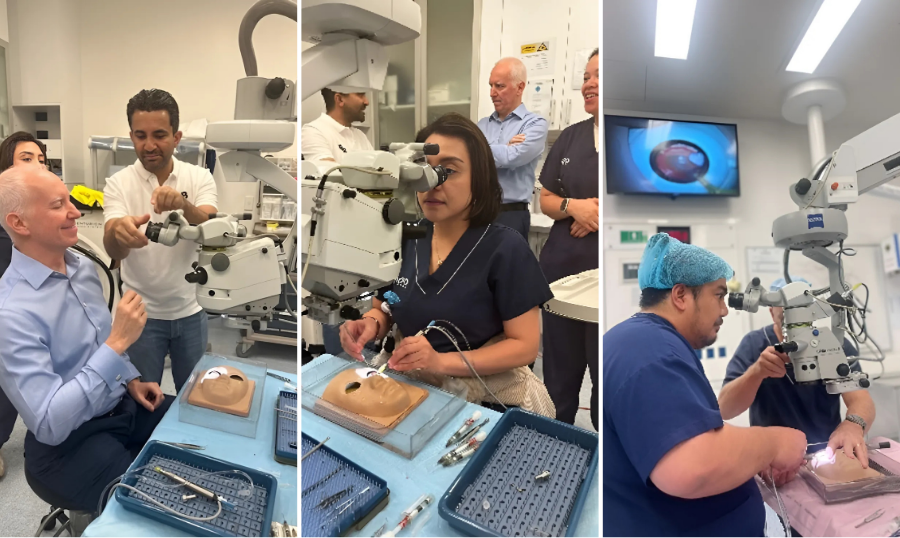Auckland Eye sets new standard in digital accessibility with website toolbar launch
Discover how Auckland Eye is redefining inclusive healthcare by launching New Zealand’s first assistive website toolbar.

When the sclera (white part of the eye) appears reddened, causing bloodshot eyes, this symptom can indicate a number of conditions. The severity and appearance of red eyes can vary widely depending on the cause. In some instances it can look like there are several squiggly red or pink lines on the sclera or the entire sclera may appear diffused pink or red.
Red eyes can occur in one or both eyes and can be associated with several other symptoms including irritation, burning, itching, dryness, pain, discharge, watery eyes, sensitivity to light, blurry vision.

Red eyes occur when the small blood vessels that are present on the surface of the eye become enlarged and congested with blood, making them more visible. These tiny blood vessels can become dilated (causing bloodshot eyes) due to a number of different reasons including environmental or lifestyle-related factors and specific eye problems and conditions.
Environmental Causes of Bloodshot Eyes:

1. Conjunctivitis: Conjunctivitis, otherwise known as pinkeye, is an infection that includes swelling and irritation of the conjunctiva (the thin transparent membrane that lines the eyelid and loops back to cover the white part of the eye). An infection of the conjunctiva irritates the blood vessels causing them to swell up, resulting in the whites of the eyes appearing reddish.
2. Allergies: Allergies can cause chronic itchy red eyes.
3. Dry Eye Syndrome: Dry eye syndrome is caused by a chronic lack of sufficient lubrication and moisture on the surface of the eye causing a sore, gritty sensation and reddened appearance.
4. Digital Eye Strain: Eye irritation and discomfort linked to digital eye strain has become a major job-related complaint. The symptoms can range from physical fatigue, dry eyes, eye twitching and red eyes. This discomfort is caused by a combination of factors associated with computer use, including our reduced blink rate when concentrating on screens, straining to focus on small print for extended periods of time and the high energy blue light emitted from digital screens causing eye discomfort.
5. A Scratch to the Cornea or Grit in the Eye: A red and painful eye can sometimes be caused by a particle, such as a piece of grit, getting in your eye. If there’s something in your eye, your optometrist or ophthalmologist will try to remove it with the assistance of an anaesthetic drop. Once a foreign body is removed, you may be given antibiotic eye drops and ointment to prevent an infection occurring during the healing process.
6. Contact Lens Wear: If your eyes are frequently red, sore or swollen after wearing contact lenses, this could be due to not enough oxygen getting through the lens or contact lens irritation. Lens irritation can be caused by improper care of your lenses, poor fit of the contact lens to the shape of your eye or wearing contact lenses for too long causing your eyes to dry out and become red.
7. Recent Eye Surgery: Patients often experience slightly bloodshot eyes following eye surgery (laser vision correction, cosmetic eye surgery, etc.). However, this redness usually passes a few days after surgery once the eyes have healed.
8. Subconjunctival haemorrhage: A subconjunctival haemorrhage is when the white of the eye appears blood-red. The conjunctiva contains many blood vessels and capillaries and these vessels can break and cause blood to leak into the area between the conjunctiva and the white of the eye. This is often noticed after awakening and may be spontaneous or caused by coughing or sneezing, and usually requires no treatment.
Although, when this occurs it looks frightening, it just means a blood vessel has broken on the surface of the eye. In most cases, no treatment is required, as it usually heals on its own in a few days once the blood has been reabsorbed.
9. Episcleritis: Episcleritis is a relatively common, benign, self-limited cause of red eye, due to an inflammation of the thin clear layer of tissue that lies between the conjunctiva and sclera. Episcleritis causes mild eye pain and irritation along with eye redness. Episcleritis often looks like pink eye, but it doesn’t cause discharge and in most cases, it will go away on its own.
10. Lifestyle Factors: Smoking (tobacco or marijuana) can cause red eyes, as can significant alcohol consumption. Additionally, too much sun exposure and insufficient sleep are also common lifestyle-related causes of red eyes.
11. Certain Medications: Many common medications that some people take on a daily basis can cause bloodshot eyes. Antihistamines, sleeping pills, anti-anxiety pills, and some pain relievers like ibuprofen cause dryness and redness by reducing blood flow to the tissue in and around the eye.
Red eyes are generally not a reason to be overly concerned as the common conditions that cause red eyes don’t tend to affect your vision and many of the conditions (listed above) often get better within a week or two with minimal intervention. However, if your red eyes are coupled with eye pain, excessive light sensitivity or impaired vision this can indicate a serious medical problem or underlying eye condition that may require medical attention, including:
1. Uveitis: Uveitis is inflammation of the uvea — the middle layer of the eye that consists of the iris, ciliary body and choroid. The main symptom of uveitis is redness, light sensitivity and eye pain. Symptoms of this condition can arise rapidly and get worse very quickly. Uveitis is a serious condition so it’s important to see your eye doctor at the first sign of a problem.
2. Eye Trauma or Injury: Redness can sometimes occur with an eye injury. Injuring your eye could be as simple as sticking yourself with a mascara wand or accidentally wiping your eye with a sharp fingernail. When you injure your eye, blood vessels inside the eye enlarge and dilate to bring blood and cells to heal and repair the injury.
3. Corneal Ulcer or Infection: A corneal ulcer is an open sore on the cornea caused by an infection on the thin clear front wall of the eye. In this case, if the eye’s cornea becomes infected, nearby blood vessels become enlarged and swollen as cells rush in to help fight the infection. These cells can cause visible redness, along with other symptoms including mild to severe discharge, pain, blurred vision and headaches.
4. Blepharitis: Blepharitis arises due to dysfunction of the oil secreting glands on the edges of the eyelids and can cause chronic redness and irritable eyes. If the tear function is affected the eyes can be dry but may also over-water to try to compensate and you may notice a gritty or burning sensation in your eyes, excessive tearing, itching, red and swollen eyelids, dry eyes, or crusting of your eyelids. The condition is not contagious and usually does not cause permanent damage to your eyesight.
5. Acute glaucoma: Acute glaucoma is an increase in pressure inside your eye. Your eye may be very red and painful, and you may feel sick and see haloes around lights. Additionally, your vision may be blurred or cloudy. This is a serious condition and could lead to permanent loss of vision if not treated quickly.

Depending on the cause, red eyes can develop suddenly or gradually over time and in most cases should pass within a few days. However, if you notice any changes in your vision or experience any pain, we recommend you see an eye doctor as soon as possible to pinpoint the cause of your red-eye problems and develop a treatment plan.
Common treatments include eye drops, antibiotics, creams, and oral medications. Most conditions are readily treatable and, if caught early, do not cause any permanent long-term damage.
If you have been experiencing persistent red eyes, to book an appointment with one of our highly specialised and skilled ophthalmologists, call 0800 25 25 93.

Discover how Auckland Eye is redefining inclusive healthcare by launching New Zealand’s first assistive website toolbar.

Macular degeneration is a leading cause of vision loss in older adults. There’s no cure, but its progression can be slowed. Here’s what to know.

Auckland Eye hosted an extraordinary Continued Medical Education (CME) day titled “Walk in Our Surgeons’ Shoes (Socks)”.